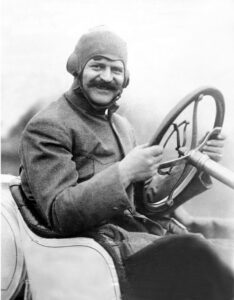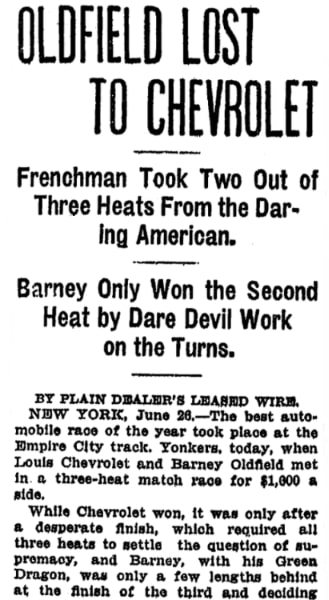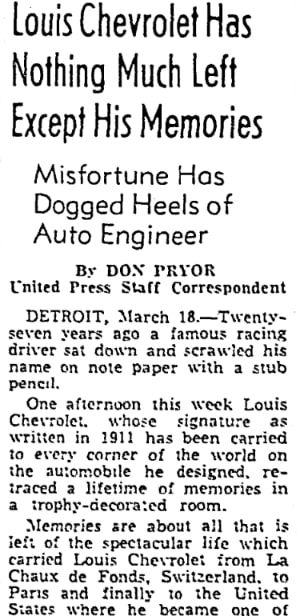Introduction: In this article – to celebrate the exciting Indianapolis 500 race this past weekend – Jane Hampton Cook writes about a racing pioneer and car designer, Louis Chevrolet. Jane is a presidential historian and author of My Country ’Tis of Thee for children. Her works can be found at Janecook.com. She is also the host of Red, White, Blue and You
My youngest son CJ, a fourth-grader, was assigned writing a paper about an American from history and giving an oral report about that person in costume. At the end of his presentation, his friends were supposed to guess who he was.
Because CJ loves cars – so much so that he reads about cars on U.S. News and World Report – I encouraged him to choose Henry Ford. CJ, however, thought Henry Ford, who invented the Model T and made cars affordable to average Americans, would be too easy for his friends to guess.
Instead, CJ looked up the name behind the Chevrolet car brand, Louis Chevrolet (1878-1941). As it turns out, there are no children’s biographies about Chevrolet. I turned once again to my go-to database for historical research for my history books, GenealogyBank.com, to find information. Here is what my son and I discovered about Louis Chevrolet.

Louis Chevrolet was born in Switzerland on Christmas Day in 1878. Moving to Paris as a child, Chevrolet grew up as a Frenchman. In 1900, Chevrolet moved to the United States and worked for a French automobile company. By 1905, he became a race car driver and raced into American history. In 1915 he became a naturalized American citizen.

This article reports:
Guiding a 90-horsepower Fiat racer with eye of hawk and nerve of steel, Louis Chevrolet, the daredevil automobilist, covered a mile yesterday afternoon in 52 1/5 seconds at the Morris Park racetrack, thereby breaking the world’s record of 52 4/5 seconds for a mile with a flying start, made with the same machine and on the same track on May 30 last.
As if he had a moving camera, the reporter described the time trial in great detail:
The start for the trial was made on the backstretch, well in view of the grandstand. The first time past the stand M. Chevrolet came so fast that he had to shut off the power altogether to make the paddock turn. Had he been able to hold the headway which he thus lost he would undoubtedly have clipped at least two more seconds off the record. As it was, the nervy Frenchman took the turn so fast that a cry of consternation went up from the spectators on the clubhouse lawn.
He righted the powerful machine, however, and thundered down the backstretch at a rate of over seventy miles an hour. He was obliged to slow down to take the far turn, but as soon as the car was straightened out for home M. Chevrolet opened the throttle wide. He crossed the finish line at such a tremendous speed that it was with great difficulty that he negotiated the paddock turn, although he shut off the power as soon as he passed the line. The spectators were loud in applause of the feat, but all breathed a sigh of relief when it was over without a mishap.
After Chevrolet broke the record, he drove the New-York Tribune reporter around the track. Though a common speed today, covering a mile in 59 seconds was terrifying to the reporter:
For a novice, the sensation of such extreme speed is frightful. On the straightaway it seemed like flying. Beneath the speeding car the pulsations of the throbbing motor were nearly drowned by the whistling of the wind which the machine created. The car was a thing of life which answered every move of the rigid figure which guided its destiny with such consummate skill. Now and again the driver glanced at the writer and a smile curled at the corners of his mouth. The reporter realized that it was no time to show the white feather, so he braced anew, took a tight hold of his hat and waited.
In a twinkling the far turn was reached. This is sharp and hard to negotiate. M. Chevrolet assumed a more tense pose and drove straight for the outside rail… Again did M. Chevrolet twist the steering lever in the nick of time. Now he held the flying car close to the rail, and seemed to fairly shave the fence in passing. At last, with a horrible skidding of the wheels the curve was accomplished, and the panting car was dashing down the stretch.
…The machine was stopped at the stand with difficulty, and the reporter, feeling as if he had passed through the shadow of the valley of death, stepped out of the car, thankful to stand again upon the solid ground. M. Chevrolet, cool and unconcerned, remarked that the “Engine was a little hot or we would have gone much faster.” The reporter blessed the engine.
Sixteen days later, Chevrolet faced the best driver in America, Barney Oldfield, and beat him two out of three heats.

This article reports:
The best automobile race of the year took place at the Empire City track, Yonkers, today, when Louis Chevrolet and Barney Oldfield met in a three-heat match race for $1,000 a side.
Called the Flying Frenchman, Chevrolet drove a 90-horsepower Fiat car and defeated Barney Oldfield, a crowd favorite:
While Chevrolet won, it was only after a desperate finish, which required all three heats to settle the question of supremacy, and Barney, with his Green Dragon, was only a few lengths behind at the finish of the third and deciding heat.
In a racing career that lasted from 1905 to 1920, Chevrolet won 27 races. He was also a car mechanic and designer, and co-founded the Chevrolet Motor Car Company in 1911.
In 1938, three years before he died, the Corpus Christi Times published a long article detailing his ups and downs as a race car driver, and his successes and failures as a businessman.

As this article points out, one of Chevrolet’s highlights was launching the car that carries his name. This car included new features, such as a gear shift in the middle of the car. Chevrolet’s business partner, William Durant, eventually brought the Chevrolet car into the General Motors company. Over time, millions would buy a Chevrolet, a brand that has lasted over a century. But as successful as the Chevrolet car was in his time, Louis preferred designing racecars. His cars won the Indianapolis 500 in 1920 and 1921.
Louis Chevrolet died in 1941 and was buried next to his race-car-driver brother, Gaston, in Indianapolis, eight miles from the Indianapolis Motor Speedway.

This article reports:
He [Chevrolet] died a tired old man, somewhat embittered at a fate that dropped him from world note to virtual obscurity.
Explore over 330 years of newspapers and historical records in GenealogyBank. Discover your family story! Start a 7-Day Free Trial
Note on the header image: Louis Chevrolet, 4 July 1919, photographed by Marvin Dement Boland. Credit: Tacoma Public Library; Wikimedia Commons.
